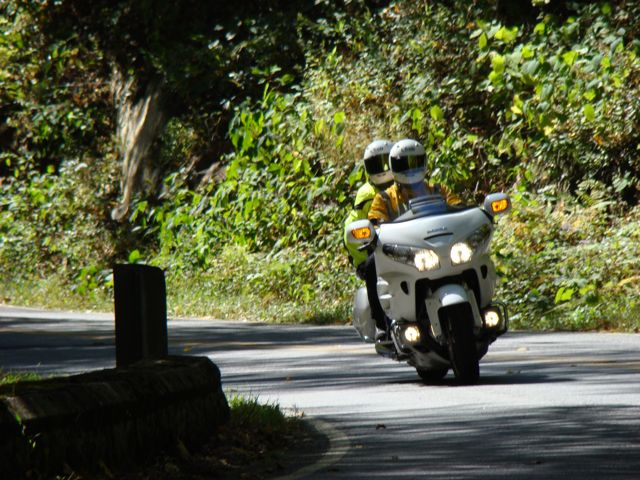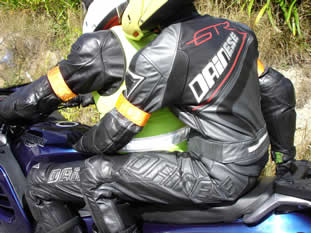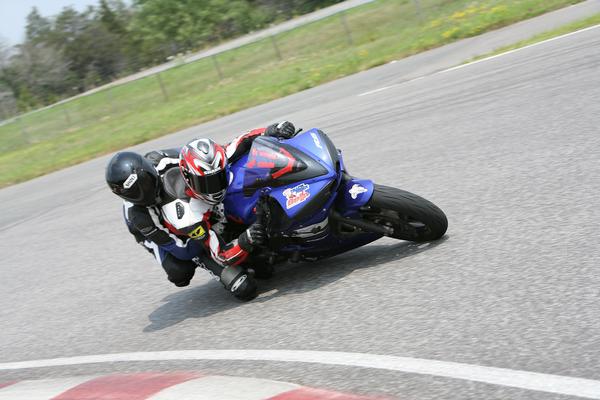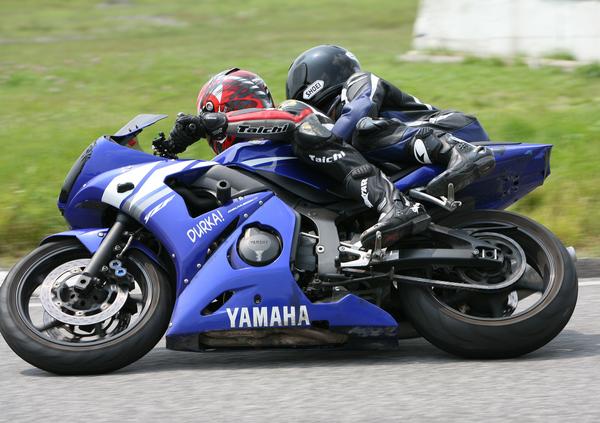Though you might think there isn’t much to say, riding as a passenger is even harder than learning how to ride a motorcycle. The same applies for the rider himself, as riding with a passenger requires even more skills than riding alone. There are no schools to teach people how to ride as passengers, so this is something you should learn from the advices of experienced riders... or experienced passengers.
When riding with a passenger, the bike is heavier and won’t steer as easily or brake as fast. Moreover, it is more difficult to balance at a stop.
Any sudden move of the passenger can cause the rider to lose control of the motorcycle and crash. The rider is also more "under pressure" when carrying a passenger, since now it’s not his life alone he has to take care of..
First Time?
If you have never been a passenger on a motorcycle before, the first thing you should do is find a rider with experience, both in riding motorcycles and carrying passengers. When you find the rider, you should inform him whether it’s your first time or not and ask him to give you a quick safety lesson.
He will tell you when and how to mount and dismount properly, what to do when you corner, brake and stop and how to communicate essential messages while on the move. Most likely, your rider will also provide you with the proper protective gear. For a first time it's also important not to take a long distance ride. Ask your rider to take you on a couple of short rides first for you to get used to it. There are cases in which after the first ride, some passengers were too frightened to repeat the experience.
Never turn or make sudden moves, since it could affect the rider’s ability to safely control the motorcycle. As a passenger, you should always hold onto the rider’s waist or the bike’s passenger handholds. At least one hand should be around his waist all the time. Never hold onto his shoulders or arms, or to any strap attached to the seat.
When cornering, your body position also has a strong influence on the steering and lean angle. You might get frightened when the bike leans and it could make you lean out of the corner to try and straighten the motorcycle up. This will have the opposite effect and will make the rider lean the motorcycle even deeper into the corner to maintain his arc, so you should stay neutral and look over the rider’s inside shoulder.
Even if you are riding as a passenger, you should pay attention to the traffic situation too, so you can anticipate what might happen. During heavy braking, you will probably be pressed against the rider, so you should brace your hands against the tank when braking. When accelerating or decelerating, your helmets could bump against each other. It happens, and you shouldn’t apologize for that. It is usually the rider’s fault because he isn’t riding as smoothly as he should.
Ride safe!
He will tell you when and how to mount and dismount properly, what to do when you corner, brake and stop and how to communicate essential messages while on the move. Most likely, your rider will also provide you with the proper protective gear. For a first time it's also important not to take a long distance ride. Ask your rider to take you on a couple of short rides first for you to get used to it. There are cases in which after the first ride, some passengers were too frightened to repeat the experience.
Communication
There are some conventions that have to be established when you are on the move. Don’t think that right after you mount the bike it will be all clear until you reach your destination. Just to be sure, it’s for the best to have a basic plan for your on-bike communication. During a ride around town it’s pretty easy to speak with the rider, but it’s tougher on the freeway, so you should decide on a few basic hand signals. You should have signals for ‘stop’, ‘slow down’, or ‘I have a problem’, as well as for anything else you might think of. You should discuss about the ride at each stop, sharing opinions.The Gear
There is not much to say about the gear, since there are only a few differences between the rider’s gear and the passenger’s. The helmet and the jacket are a must have. If you are planning on having a long-term ‘passenger job’ you should consider buying your own helmet. You don’t get to wear the boots and gloves, though if they are provided it’s for the better. This doesn’t mean that slippers are allowed. As long pants are also recommended, jeans would work just fine.Basic Tips
Always wait for the rider’s approval to get on or off the bike. You are the one who mounts second and dismounts first. You should always mount the bike from its left side (the exhaust is on the right side, so you have to avoid touching it). You have to be tall enough to reach the footrests. Yours, not the rider’s. The whole time when you are on the move you should keep your feet on the footrests.Never turn or make sudden moves, since it could affect the rider’s ability to safely control the motorcycle. As a passenger, you should always hold onto the rider’s waist or the bike’s passenger handholds. At least one hand should be around his waist all the time. Never hold onto his shoulders or arms, or to any strap attached to the seat.
When cornering, your body position also has a strong influence on the steering and lean angle. You might get frightened when the bike leans and it could make you lean out of the corner to try and straighten the motorcycle up. This will have the opposite effect and will make the rider lean the motorcycle even deeper into the corner to maintain his arc, so you should stay neutral and look over the rider’s inside shoulder.
Even if you are riding as a passenger, you should pay attention to the traffic situation too, so you can anticipate what might happen. During heavy braking, you will probably be pressed against the rider, so you should brace your hands against the tank when braking. When accelerating or decelerating, your helmets could bump against each other. It happens, and you shouldn’t apologize for that. It is usually the rider’s fault because he isn’t riding as smoothly as he should.
Ride safe!



